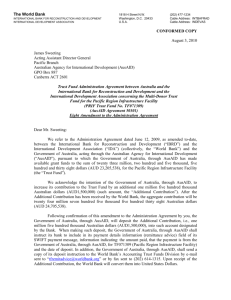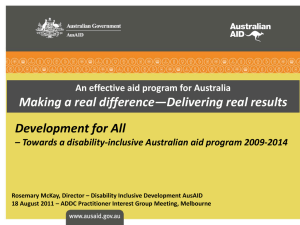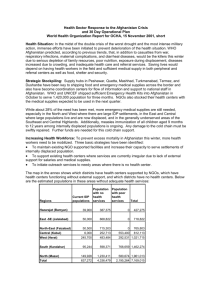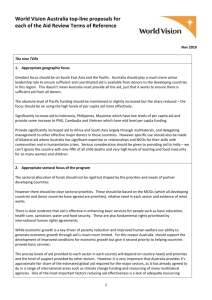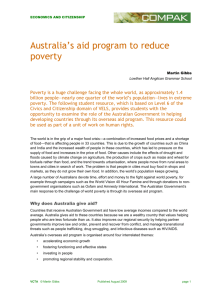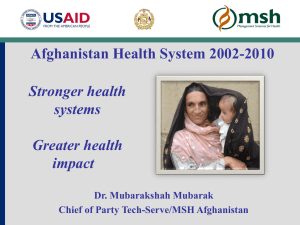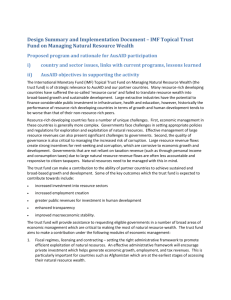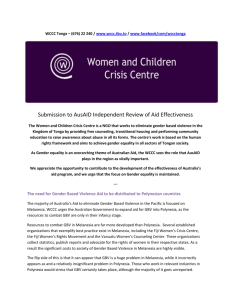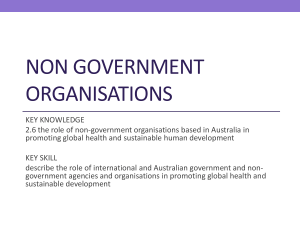Section 2: Activity Description and Operational Objective
advertisement
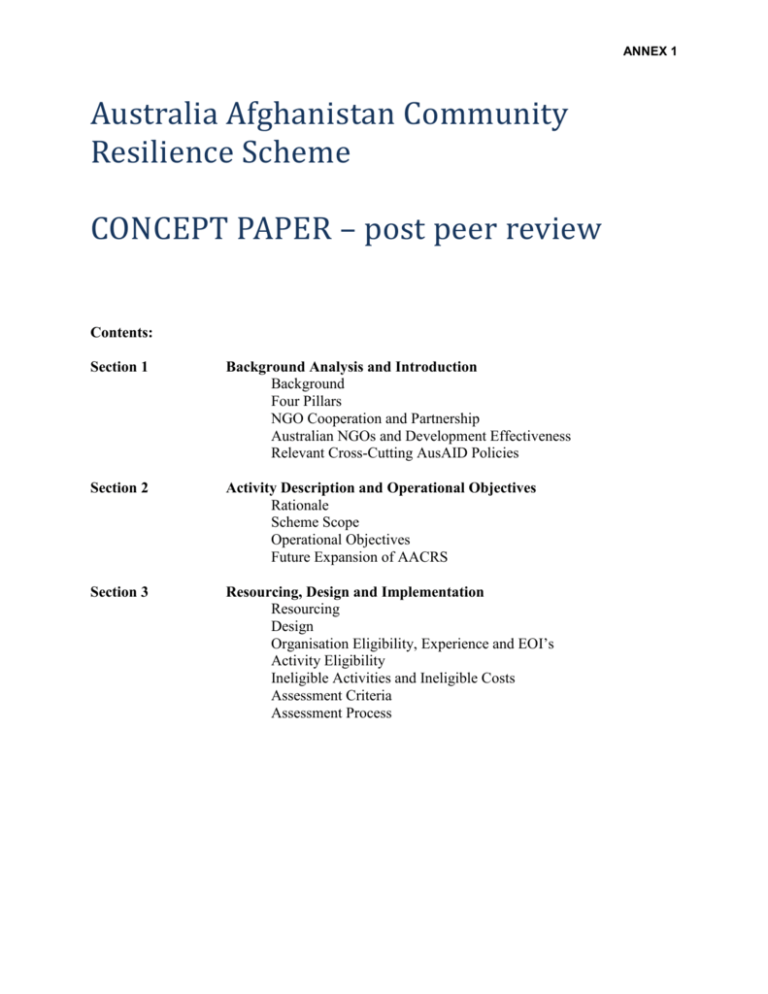
ANNEX 1 Australia Afghanistan Community Resilience Scheme CONCEPT PAPER – post peer review Contents: Section 1 Background Analysis and Introduction Background Four Pillars NGO Cooperation and Partnership Australian NGOs and Development Effectiveness Relevant Cross-Cutting AusAID Policies Section 2 Activity Description and Operational Objectives Rationale Scheme Scope Operational Objectives Future Expansion of AACRS Section 3 Resourcing, Design and Implementation Resourcing Design Organisation Eligibility, Experience and EOI’s Activity Eligibility Ineligible Activities and Ineligible Costs Assessment Criteria Assessment Process ANNEX 1 Section 1: Background Analysis and Introduction Background The challenges faced by Afghanistan remain daunting. Ongoing conflict and insecurity is a fundamental impediment to development progress. Insecurity inhibits the delivery of basic health and education services, prevents the construction of necessary infrastructure and curtails jobcreating, private sector activity. Insecurity is also at the heart of uneven development progress across Afghanistan. The capacity of the Afghan Government, at national, provincial and district levels, is low. Major challenges include poor levels of education and qualified personnel, underdeveloped budget planning and implementation capacity, and weak transparency and accountability mechanisms. These weaknesses directly affect the Government’s ability to deliver services to the population. While growing in its reach, the Central Government still has a light footprint outside Kabul and major provincial capitals. For many years, Afghans living in rural areas have had little contact with their Government. This has kept the levels of general knowledge about the role and responsibilities of government low. Powerbrokers at provincial and district levels have a strong influence over the development prospects of local Afghans. Afghanistan is a highly agrarian society with around 80% of the population living in rural areas. Agriculture and livestock account for about half of total legal Gross Domestic Product (GDP) and 60% of employment.1 Despite growing production and exports, for many Afghans, farming is still largely subsistence. This makes them vulnerable to natural disasters such as droughts and floods, and other vulnerabilities such as increased food prices. The concept of a community resilience scheme delivered through Non-Government Organisations (NGO) originated as a response to a number of factors. AusAID has recognised, through preliminary work on an agriculture development strategy, the potentially important role played by Australian, international and local NGOs in providing support to and strengthening of Afghan communities. The role played by NGOs is not in competition with Afghan Government service delivery but forms part of a diversity of approaches that underpins rural development. The capacity of rural communities in Afghanistan to deal with cyclical climatic events such as droughts and floods has been weakened over time by conflict and insecurity. NGOs play a valuable role in supporting communities to build their resilience and to advocate for improved service delivery from all levels of Government. The recent review of the aid program and government response point to the importance of strengthening civil society. Four Pillars Under AusAID’s current Afghanistan Country Strategy, AusAID bases its support to Afghanistan on four pillars: enhancing basic service delivery in health and education supporting rural development and livelihoods improving governance and the effectiveness of the Afghan Government supporting vulnerable populations. 1 World Bank, Interim Country Strategy Note, report no. 47939–AF, May 5 2009. ANNEX 1 In delivering assistance, Australia seeks to work through Afghan systems, consistent with the international community’s commitments at the 2010 London and Kabul Conferences at the same time, AusAID recognises that in conflict and recovery, NGOs play a valuable role in support of communities through service delivery and demand for better governance. NGO Cooperation and Partnership Australia works closely with NGO partners in Afghanistan, including as implementing partners of central Afghanistan Reconstruction Trust Fund (ARTF) programs. AusAID will continue to provide funding for Australian NGOs through the AusAID NGO Cooperation Program (ANCP) and this funding can be programmed for activity in Afghanistan if NGOs so wish and prioritise. The AusAID policy on engagement with civil society is currently under development. More broadly, An Effective Aid Program for Australia states that “the Government will develop, in consultation with the Australian Council for International Development, a new Civil Society Engagement Framework. This will set out how Australia will work more effectively with civil society organisations, in Australia and overseas, to increase the impact of aid for the world’s poorest.”2 The Government also agreed to implement the following recommendation of the independent review: Recommendation 10: The aid program should increase its emphasis on private sector development and strengthening civil society. Policy statements in relation to each should be developed. Preliminary work that pre-dated the release of An Effective Aid Program for Australia, AusAID’s approach to working with civil society identifies three areas of possible activity.3 Whilst AusAID policy on civil society engagement will be revised in 2012, those three areas provide a useful guide in the interim: Policy dialogue: contributing to policy program and strategy development in Australia and overseas. Program delivery: facilitating better access to basic service delivery and humanitarian activities for poor and vulnerable communities; strengthening the role and capacity of civil society in partner countries; and supporting governance systems to work better for the poor. Increasing the transparency of Australia’s aid program, both within Australia and abroad: undertaking development awareness activities and informing the broader community on international development issues; facilitating people to people and organisational links through volunteer and other programs. An Effective Aid Program for Australia: Making a real difference – Delivering real results, p. 55. Taken from the AusAID NGO and Community Engagement Section discussion Paper, “AusAID Engagement with NGOs”, draft, October 2009. This paper reflects the development of AusAID thinking on engagement with NGOs prior to the aid review and the details are subject to change. 2 3 ANNEX 1 Australian NGOs and Development Effectiveness The Australian Council for International Development (ACFID) has sponsored several years of research focused on increasing the development effectiveness of ANGOs4. The research suggests that ANGOs undertake the most effective development work in locations where they operate for a long time and are able to experiment, make mistakes and work with particularly marginalised and poor people through a relationship-based approach. Further, that effective development work is most often undertaken through a ‘joined up’ approach that links delivery of services with a focus on people's rights. Activities most often include a mixture of service delivery, capacity development, awareness-raising and research. How to work in partnership with other organisations, particularly fledgling civil society organisations in poor countries, and how to develop the capacity of these organisations is a particular area of interest for many ANGOs. Some ANGOs have also started to re-examine the relationship they have with their Australian public donors. With changing communication opportunities, there is now more direct communication between people in Australia and people in other countries who are served by ANGOs and their partners. This increased communication can serve to increase transparency and accountability in both directions, identifying both outcomes and resources. Some ANGOs are now experimenting with social media and other modalities to enhance these opportunities for accountability. International NGOs AusAID will explore options for including credible international development NGOs during the design phase. AusAID Accredited Australian NGOs are known entities, having (in most cases) a history of performance for AusAID and a known level transparency in their policies, procedures and financial arrangements. Other AusAID NGO programs such as the Water and Sanitation Initiative have been open to international NGOs. That program required non-accredited NGOs to provide additional information on application and allow conduct of relevant due-diligence checks prior to commencement. The design phase will examine the practicalities of this, given the constrained operating and monitoring environment in Afghanistan. Relevant Cross-Cutting AusAID policies The AusAID Afghanistan Program will be looking to work with NGOs that can demonstrate continuous learning on how to be more effective in their work. Recent developments in this sector have included an increased focus on program approaches, experimenting with strengthbased approaches to program analysis and implementation, and greater emphasis on good quality monitoring and evaluation. There are several AusAID policies which have relevance for this concept paper: Chapman, R. (2008), “A survey of Australian NGOs on development effectiveness”, ACFID. Roche, C. (2009) “ACFID development effectiveness research report”. 4 ANNEX 1 Gender and development AusAID’s policy on gender equality5 identifies that men and women have the right to be equal participants in and beneficiaries of aid and development work. It identifies the need for services targeted at women in particular to increase women's participation and to address women's health and access to education. It also identifies the need for strengthened accountability mechanisms to increase collection and analysis of information to improve gender equality results. Child protection The AusAID child protection policy6 outlines practical steps to increase AusAID’s capacity to manage and reduce the risks of child abuse associated with delivering aid activities. The policy focuses on protection of children's rights and their safety and security. It requires all implementing agencies including NGOs and CBOs to operate in line with the policy. Disability inclusiveness The AusAID policy on disability7 recognises that a disability is likely to limit the full and active anticipation of people in society and also likely to limit their access to basic services. The policy commits the agency to consider the needs and rights of people with a disability. Disaster risk reduction The AusAID disaster risk reduction policy8 aims to reduce the vulnerability and enhance the resilience of countries and communities. It recognises that disasters that result from natural hazards such as drought and cyclone occur in locations where people are vulnerable due to factors such as poverty, disability and disease. Recent experience has shown that Afghanistan is particularly prone to weather-related risks such as prolonged drought and flooding and therefore this policy will have relevance across many areas where AACRS is likely to be implemented. Anti-Corruption A clear position on Anti-Corruption is important for programming in Afghanistan given the instances of government and non-government corruption that have been reported and the frequency of community concerns over transparency and decision-making amongst government and development actors. Australia’s approach to anti-corruption in the Aid Program9 focuses on three mutually reinforcing elements: building constituencies for anti-corruption reform; reducing opportunities for corruption and changing incentives for corrupt behaviour. The opportunity exists to model best practice approaches on anti-corruption through AACRS, including transparent beneficiary selection and procurement processes. AusAID (2007), “Gender equality in Australia's aid program - why and how?”, March. AusAID (2009), “Child protection policy”, January. 7 AusAID (2008), “Development for All: Towards a disability-inclusive Australian aid program 2009-2014”, November. 8 AusAID (2009), “Investing in a safer future. A disaster risk reduction policy for the Australian aid program”, June. 9 AusAID (2007) “Tackling Corruption for Growth and Development: A Policy for Australian Development Assistance on Anti-Corruption.” 5 6 ANNEX 1 Do No Harm Donor support for civil society organisations, including NGO s, can affect state-society relations, either by increasing “voice” with positive impacts on political inclusiveness and the capacity of society to make demands on the state, or by enhancing antagonistic polarisation with a potentially negative impact on processes of statebuilding, often unwittingly affecting political processes.10 This scheme is focused on building community resilience and improving livelihoods. Working with local NGOs and social organisations to improve their service delivery may necessitate capacity building to improve ‘demand for better governance’ from the Afghan Government. In all activities, prospective partners must be cognisant of the existing conflict and apply ‘do no harm’ principles to their projects. A requirement to demonstrate application of ‘do no harm’ principles or similar will be necessary for applicants under this scheme. Section 2: Activity Description and Operational Objective The Scheme will be focused on the objective of improving community resilience and livelihoods in the face of continuing security, governance and environmental variability. For the purposes of this scheme, ‘community’ includes men and women, children, people living with disabilities and their carers. Whilst this should be self-evident, activities proposed through the scheme that can clearly articulate an approach and course of action to improve community resilience that is inclusive of this broad definition of the term ‘community’ will be more competitive. Individual partnership agreements with a number of eligible NGOs will be established through a competitive grants process. Successful NGOs will be given multi-year funding (if possible 4 years) to pursue activities in line with AACRS objectives. NGOs agreeing to take part in AACRS will be expected to cooperate with AusAID through a coordination group. AusAID and NGO partners will share information on the operating environment, successes and challenges and work to coordinate and improve long-term Australian development assistance with Afghan partners, including the Government of the Islamic Republic of Afghanistan. Rationale AusAID is seeking to make an effective contribution towards the achievement of the MDGs in Afghanistan through support for particular sectors including agriculture and rural development, health and education and governance. At commencement, this Scheme is intended to focus on agriculture and rural development, with the potential to fund other sectors, following review of the country strategy in 2012. To improve community resilience, AusAID needs to improve the focus of its funded agriculture and livelihoods work, recognising the important but different constituencies for certain activities. For example an activity to reduce individual vulnerability should focus on the poorest and most marginalised people but work identified to improve broader agricultural productivity should instead support the best, most capable farmers as technical leaders who can in turn influence 10 OECD (2009) “Do No Harm. International Support for Statebuilding.” ANNEX 1 other farmers. Civil society is an important partner in both reducing individual vulnerability and promoting improved sectoral productivity, so long as activity objectives are clearly articulated and the appropriate community partners and beneficiaries are found and partnered. Whilst grounded in service delivery, effective support for civil society can include support for civil society engagement in policy dialogue and holding governments and other stakeholders accountable for their delivery of services for poor and marginalised people. By focusing on community resilience and livelihoods, AusAID expects applicants to the scheme will focus attention towards particular groups who ought to be at the centre of Australian programs for Afghanistan. These groups include women, children, people with a disability and people impacted by conflict and disaster. Scheme scope The geographic scope for the AACRS is not limited to any particular province, though preference may be given to communities in most need of resilience building, including those subject to the current prolonged drought, given the additional burden this places on communities. Communities where applicants can demonstrate a clear, articulated community call for action or support will also be favoured. Given Australia’s national interest in Uruzgan Province, programming would be welcome here but is not mandatory. It is expected that Australian NGOs will work through local civil society partners and will utilize their experience in Afghanistan or elsewhere to capacity build and influence the way their partner organizations work in AACRS and their other programs. In line with the AusAID requirement that gender is mainstreamed through all programs, it is expected that women (as well as men) will be included as beneficiaries and participants in all of the NGO projects. Other marginalized groups which are expected to be included as beneficiaries and participants include children, people with a disability and people who have been impacted by disasters. AusAID recognizes this is difficult in Afghanistan but for this very reason will preference projects that demonstrate innovation and leadership in inclusive development in Afghanistan. Program monitoring will be expected to utilize disaggregated data to better allow evaluation of inclusiveness and impact. Operational Objectives It is proposed that the Scheme will commence with a single operational objective: Improved resilience and livelihoods for Afghan rural communities (men and women) which may include but is not limited to: o Improved economic livelihoods, including support for agricultural productivity and food security; o vocational and enterprise skills development; o access to microfinance and improved access to markets; o better natural resource management; and o a more effective regulatory environment ANNEX 1 The Scheme will provide four year funding. Figure 1: Objective and example activities, dependant on projects proposed by scheme applicants. e.g. improving natural resource management e.g. improving horticultural practice improved community resilience and livelihoods e.g. vocational training e.g. support to civil society governance structures ANNEX 1 Section 3: Resourcing, Design and Implementation Resourcing Total Funding for the initial objectives is envisaged to be around $20m over four years with an opportunity to provide additional funding to expand existing activity or if additional objective streams are added. AACRS is expected to commence activity early in 2012-13 with all necessary design work undertaken in the second half of 2011-12. Given the difficulty of working within conflict, expertise in establishing, managing and evaluating similar programs will be sought to inform the design process. Design Subject to a successful review of the concept paper, AusAID will undertake a consultative design process, with (subject to best endeavours) a design peer review in late 2012. To best contribute to the desired goal with the funding available, AACRS will be designed as a competitive grant tender for multi-year funding of up to 5 NGOs. Given the level of funding, the design of the Scheme should be relatively modest but will include an AusAID led coordination body and the development of a monitoring and evaluation framework that guides NGOs own M&E and provides for a level of independent evaluation. That framework will be based on consideration of the practicalities of working in Afghanistan and will be budgeted for in addition to the $20m project funds. Line ministries of the Afghan Government (such as the Ministry of Agriculture, Irrigation and Livestock) have NGO coordination units that seek to oversee NGO activity in their sectoral areas of responsibility. The Scheme design will need to establish a means of working with relevant Afghan government agencies and individual partners will need to work in line with lawful requests of the Government of the Islamic Republic of Afghanistan at national and provincial level. Given the ongoing conflict and insecurity in many parts of the country, Scheme architecture should include regular review points and flexibility to reprogram multi-year funds should onground circumstances require it. Organisation Eligibility, Experience and EOI’s Afghanistan is a difficult working environment for any organisation. Many AusAID traditional NGO partners do not operate in Afghanistan and a number of other credible organisations do. Additionally, AusAID is interested in maximising opportunities to engage the Australian community on the challenges and rewards of assisting Afghans to improve their resilience in the face of conflict, post-conflict and environmental challenges. Opportunities for oversight in Afghanistan are more restricted than other working environments. Given the above factors AusAID will need to consider limiting organisational eligibility to those NGOs that have a known track record of performance and transparency when operating in difficult environments. Organisations that do not have AusAID Accreditation will need to submit additional organisational information as part of their EOI, particularly in the areas of child protection policy and procedures, financial systems arrangements and development effectiveness systems. ANNEX 1 AusAID may request a spot check of non-accredited NGOs systems and record-keeping prior to finalising grant funding. During the design phase, AusAID will explore the requirements for applications from international NGOs that would approximate AusAID due diligence processes found in AusAID Accreditation. Development Experience in Conflict and Post-Conflict: Beyond organisational eligibility, organisations will be rated on their demonstrated on-ground experience in Afghanistan, in activities relevant to the agreements current operational objectives. This requirement will include application of ‘do no harm’ principles or similar. As part of the design, AusAID expects to develop a competitive tender process that commences with a call for Expressions of Interest (EOI). An EOI would include evaluations against capacity statements (60%) that demonstrate existing partnerships and experience in Afghanistan relevant to the Schemes objectives; and concept papers (40%) that demonstrate feasibility, clear theory of change (related to AACRSs expressed objective), sound monitoring/evaluation and capacity development approaches. Criteria for selection will be developed through the design phase. Activity Eligibility NGOs accepted through the EOI will be expected to prepare detailed designs for AusAID approval and coordinate their activities with other successful NGOs, particularly in relation to monitoring and evaluation and lessons learnt. In line with AusAID recommendations on working with civil society, activities can include policy dialogue and community engagement (in Australia and abroad) but applicant NGOs will need to demonstrate that such work is either directly supporting the goal of improving Afghan community resilience or appropriately ancillary to the main body of work proposed that does directly contribute to improving community resilience. AusAID acknowledges the relative cost of working in Afghanistan, particularly in relation to provision of security. Security is a legitimate project expense and will be assessed as part of value for money considerations along with other project costs. Ineligible activities and ineligible costs The design will consider adopting all ineligible costs currently listed in ANCP guidelines and guiding principles, such as welfare and proselytising. Assessment Criteria The criteria against which proposals will be assessed and the weighting for each criterion will be clearly specified in the Scheme Specific Guidelines as part of the design development. The final package of proposals will be selected for funding on the basis that they will best contribute (as a whole) to the Scheme’s stated outcome. Assessment Process A two-step process is envisaged with: ANNEX 1 1. initial Expression of Interest (capacity statements and Project Concept Paper (with short budget) submitted; and 2. subject to satisfactory assessment, AusAID invitation to submit a full activity proposal. The scheme design will explore options to utilise a funded activity design process, whereby successful NGOs (based on EOI and concept paper) could be paid an initial grant to enable finalisation of their designs. Further funding would be subject to AusAID acceptance of the full activity design. ANNEX 1 Acronym List AACRS: ACFID: ANCP: ANGO: ARTF: AusAID: EOI: GIRoA: MAIL: ODE: Australia Afghanistan Community Resilience Scheme Australian Council for International Development AusAID NGO Cooperation Program Australian Non-Government Organisation Afghanistan Reconstruction Trust Fund Australian Agency for International Development Expression of Interest Government of the Islamic Republic of Afghanistan (Afghan) Ministry of Agriculture, Irrigation and Livestock Office of Development Effectiveness
